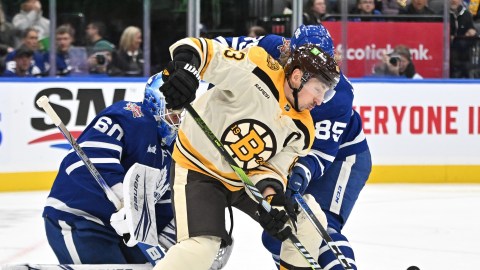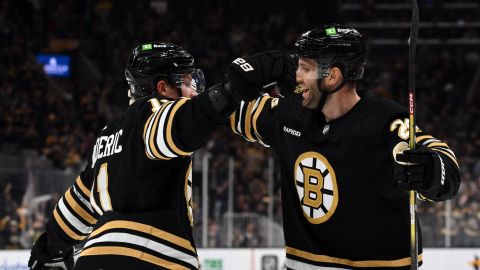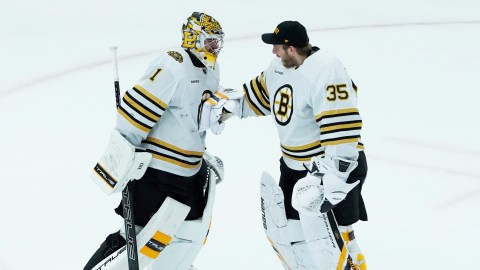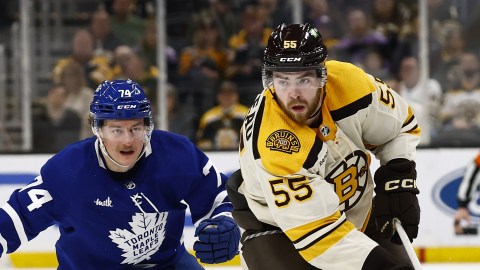Say it a few times. Now go stand in front of a mirror and say it with conviction, or with one eyebrow lifted, or while sitting back in an overstuffed chair. Now say it once more as if you are a paid pundit. Congratulations! You’ve got the job!
It’s funny how Peter Chiarelli is too much in love with stability.
On the other hand, Ray Shero is a genius for inheriting a team that stunk worse than a week-old dead mouse. When Shero signed on, the Pens had the likes of Sidney Crosby, Evgeni Malkin, Marc-Andre Fleury and Brooks Orpik ready and waiting. They also stunk so bad that they had secured the No. 2 overall pick Shero would use to select Jordan Staal.
Staal and his $4 million salary is on the injured/non-roster list right now, which is a good thing because Shero is going to have to shed $3.6 million of cap space as soon as his No. 3 center recovers from the infection in his foot incurred by playing through a sliced tendon during the 2010 playoffs.
When Staal gets healthy, Pittsburgh will have a few no-movement clauses that will take players out of the mix: Crosby (why would they, anyway?), Malkin, Orpik, Paul Martin, Fleury and everyone’s favorite felon, Matt Cooke (although Cooke’s signing didn’t feel so much like pen on paper to him as “shoulder on shoulder,” right?).
The Pens won the Stanley Cup two years ago. Then they had to jettison both halves of their best shutdown defense pair — Rob Scuderi going to L.A. and Hal Gill to Montreal. Gill immediately showed Pittsburgh what it gave up by helping the Habs, ahem, shut down the Pens in the second round of the playoffs.
The Penguins have at least eight players who will become unrestricted free agents at the end of this season, according to CapGeek, Hockey Buzz Cap Central and NHLnumbers. None is in the Penguins’ core, although Max Talbot “both-goals-in-Game-7” is in the group of gonna-be-frees.
Speaking of Cup-winning goals, let’s look at Chicago and Patrick Kane. The No. 1 pick from 2007 has a deal through 2015. Same for Jonathan Toews. Brian Campbell is signed through 2016. Marian Hossa‘s pact lasts through 2021, and Duncan Keith‘s goes through 2023 (down, Gary, down!). All but Hossa have some kind of no-movement clause.
No sooner had the 2010 champions showered off the champagne than they were spraying players around as if they were golden retrievers fresh out of the river: Kris Versteeg and his two consecutive 20-goal seasons to Toronto (which is a perfect 3-0 as of this writing, NESN.com blog loyalists). Dustin Byfuglien and his 11 playoff goals led a slew spewed toward Atlanta that included Andrew Ladd, Ben Eager and Brent Sopel. Chicago kept its core intact, but has five players slated for unrestricted free agency at the end of this season (again, according to CapGeek, Hockey Buzz Cap Central and NHLnumbers).
Chiarelli inherited the Phil Kessel pick and — three summers later — elected not to keep Kessel in his core of players. He could have done the wine-and-dine thing to schmooze Kessel and never let the discussion reach the point of “a player who didn’t want to play here,” but Chiarelli and his associates decided that Kessel and a big cap-unfriendly deal weren’t core material. The Bruins missed Kessel’s scoring more than anyone predicted last season. So far, they have No. 2 overall 2010 draft choice Tyler Seguin skating on their club and promises of more to come.
You make trades, you take risks, you get destroyed by second-guessers when you miscalculate. It’s part of the territory to be one of 30 men making the decisions for a professional hockey organization.
Versteeg for Brandon Bochenski was a bomb. Kessel for Seguin and more? The jury is still out, although there are some good early returns.
But one thing we know: Without second-guessing a general manager, there’s a lot less to talk about. It’s de rigueur to savage every bad move from the safe ground of “I’m-saying-I-told-you-so-but-I-actually-didn’t.” Yet pundits have zero recall when they’re wrong, which is far more often than they’re right.
It would be more impressive if, every time a pundit made a hard-and-fast prediction, he faithfully revisited his veneer-deep one-liners after reality had created some substance.
Did anyone out there write or say, last September, that Tuukka Rask was going to lead the league in save percentage with a sub-2 goals-against average? If so, please show me the dated document. It’s bull. No one saw Rask emerging that fast and that strongly. Tim Thomas was coming off a Vezina Trophy season, he was a relatively low-mileage goalie (fewer NHL games played than any other upper-echelon goalie his age), he was going to be an unrestricted free agent, he was about to turn 35, and his magic number was $20 million. Chiarelli spread out the money as best he could, accepted Thomas’ desire for a no-movement clause and signed him up.
Patrice Bergeron‘s cap hit is increasing by about a quarter-million dollars per year at the beginning of next season. Zdeno Chara‘s cap hit is going down by about $600,000. Marc Savard‘s cap hit is $1 million lower than it was last season. Have a problem with any of those? Or did you know in advance that Matt Cooke was going to have a rule created in his own cheap-shot image?
The Bruins have Mark Recchi (on a one-year deal at age 42), Mark Stuart, Marco Sturm and Michael Ryder due to become unrestricted free agents at the end of this season (in addition to Brian McGrattan, who has yet to appear in a game, and Trent Whitfield, who won’t because his Achilles tendon exploded).
That is far less luggage than virtually any other contending team.
It’s terrific to sit there and be a pundit and say, “This guy shouldn’t have gotten a no-movement clause” or, “That guy got too many years” (OK, Andrew Ference‘s three-year deal is worth discussion). If a team doesn’t come to agreement with a player, it not only introduces the possibility of distraction during the season but also runs the risk of forfeiting the player’s value at season’s end. Or having to overpay (or overpay more, depending on one’s opinion).
If the pundits would examine the subtraction they are suggesting, not to come to agreement with players who are UFA-bound, they might come up with something a bit less provocative (talk show executive producers blanch at the thought) but a lot more balanced. Timing and circumstance become considerable factors in a negotiation.
If you were the GM of the Bruins in early April 2009, do you stonewall Thomas and let him walk in the summer of 2009? Would you get him back in Boston for fewer years, less money? Oh, if you had waited until July 1, 2009, and free agency, Thomas’ signing would have come after his 35th birthday — which would have destroyed the signing team’s ability to amortize a potential buyout. A Vezina Trophy winner on the open market was going to get what he wanted. Going into a hoping-for-the-Cup season (2009-10) without Thomas would not have been sound reasoning.
The perceived problems the pundits say Bruins have with long-term contracts and no-movement clauses are much the same as many other teams in the current contract environment. Should the Bruins go against the flow? How did that work out for the B’s and the Capitals, the only two teams that obliterated their rosters before the lockout and before the NHL Players’ Association unpredictably acquiesced with a 24-percent giveback? Going it alone in a financial collective such as the NHL, precedent shows, is a recipe for disaster.
If a team decides it is going to hard-line players on contract issues, as one easily can infer from the pundits’ desultory tones, it signals to its would-be free agents to venture forth — possibly never to return. That old GM in the Greek League, Aesop, said, “Be thankful for what you have and look after it.” If you have a chance to sign them and you’ve thought it through, do it now.
You don’t trust Chara to last? If I were a betting man, I would take the bet.
You think the Bergeron signing is a bad one? Do you watch the games? He’s 25 and that glittery gold thing around his neck last February signifies Team Canada’s belief that he had pretty decent value as a player.
What Chiarelli has done is to make projections on where certain players will fit on his team. He has revealed the Bruins’ core.
Here is a table of next year’s cap hits. The Bruins listed all have no-movement clauses on multiyear contracts that terminate with unrestricted free agency (that’s why you don’t see David Krejci‘s name). We have drawn the fairest comparable players from the last two Stanley Cup winners. Numbers are from previously referenced cap-crazy websites and are rounded to the nearest hundred thousand dollars (we should all be so lucky):
| Bruins Player | Signed Through | Cap Hit | Comparable To | Signed Through | Cap Hit |
| Zdeno Chara | 2018 | $6.6M | Brian Campbell | 2016 | $7.1M |
| Tim Thomas | 2013 | 5.0M | Marc-Andre Fleury | 2015 | 5.0M |
| Patrice Bergeron | 2014 | 5.0M | Jordan Staal | 2013 | 4.0M |
| Nathan Horton | 2013 | 4.0M | Marian Hossa* | 2021 | 5.3M |
| Marc Savard | 2017 | 4.0M | Jonathan Toews | 2015 | 6.3M |
| Milan Lucic | 2017 | 4.0M | Dave Bolland* | 2014 | 3.4M |
| Dennis Seidenberg | 2014 | 3.3M | Brooks Orpik | 2014 | 3.8M |
*Hossa and Bolland are the only players in the chart not to have no-movement clauses, according to the cap web sources.
So, really, do you not like what Chiarelli has done? If another GM overspends on, say, a Brian Campbell, it sets a financial bar that may be artificially high. However, that bar does exist. Agents earn their money by empowering their players’ strengths when holding the hammer. It’s reality. Would you rather have some of the players from the right column than the left? That’s a nice argument, but (A) could you get them, one-for-one, and (B) would the right-column players agree to waive a no-movement clause?
It’s easy money to sit behind a microphone or in front of a camera and rip a signing for this or that, but line-item vetoes and 20-20 hindsight don’t exist in the real world of the NHL rosters, the salary cap and contracts.
Some of the players in the Bruins’ core, probability tells us, will either underperform or flame out before their contracts expire. But can you live with this core? If not, say so and put it on the record — because should these players combine to do something really special, you should order up a full helping of crow and eat ’til you puke before uttering the first word of praise.
Success is expensive in money, terms and years. Pittsburgh had to give up a lot after it won. Chicago’s roster virtually exploded its peripheral parts away. A GM makes his choices on players he wants to keep and knows that if he’s wrong, he’s gone. And that, if he’s right, he’ll probably have to tear down the walls in order to hold onto the frame.
The core is in place. Chiarelli has put the target on himself by making these commitments. Now it’s up to the players to justify their contracts and their collective place in the history of the Boston Bruins.



